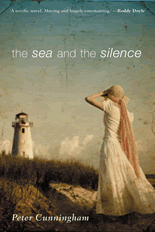Reading is much easier than writing, and I’ve always considered an hour lost in a book as one of life’s great luxuries.
 I’ve also tried to justify it as a sleep-aid, but that must be averaged out with the many nights a good story has kept me up past my usual bedtime. So it was last week with “The Sea and the Silence,” Peter Cunningham’s just-published novel about the life of an Irish woman who comes of age during the 1940’s.
I’ve also tried to justify it as a sleep-aid, but that must be averaged out with the many nights a good story has kept me up past my usual bedtime. So it was last week with “The Sea and the Silence,” Peter Cunningham’s just-published novel about the life of an Irish woman who comes of age during the 1940’s.
I was initially drawn to the book by the lovely cover. Sparse and lovely, not overdone or flashy like most covers these days. And who can resist a woman eyeing a lighthouse in the distance?
The next attraction was the word “sea” in the title. Now I’ve been suckered before into buying books by some casual reference to ocean and coast, only to be disappointed by a complete lack of watery atmosphere inside. In “The Sea and the Silence,” those two elements form a misty ever-present background, achieving importance by remaining mostly out of reach.
I’m also a sucker for historical novels, but I’ve learned that fictionalized history alone is not enough to keep me reading; the story must stand on its own. Cunningham’s lean prose drew me into Iz’s world and showed me a newly independent Ireland. My ignorance of Irish politics made it possible to take the story as it came, with no preconceived historical notions. And Iz provided plenty of perspective anyway, since these pages were written on her deathbed.
I won’t spoil the plot for you; this one has to be digested page by page to be completely appreciated. But I will tell you that the seemingly casual structure (a solicitor reading pages left behind after death) brings a new depth to the story. Without seeming to interfere at all, Cunningham allows us to see only what is necessary to move the story forward. We get tempting glimpses of the surprising conclusion that tease but never quite satisfy.
I often find endings disappointing, for several reasons. First and foremost, I seldom want to let go of a character after sharing such intimacies for 250 pages. Beyond that, a satisfying conclusion that is neither trite nor predictable requires great skill and a gentle touch. Cunningham has created a ending that felt very natural and satisfied my curiosity, without tying up all the ends too neatly.
The author lives in a coastal Irish town on which the fictional town of Monument is based. He even (yes!) provides a map that, rather surprisingly, does not reference the lighthouse where much of the book takes place. But if I weren’t in the process of deciding what to include in the frontmatter of my own book, I wouldn’t have even noticed that omission. Through the ears of Iz, I have already heard the pulse of waves beating against a shore that will be so very hard for her to leave.
Obviously I would recommend this book to anyone interested in 20th century Ireland and anyone who loves the coast. I would further encourage those who appreciate the details and structure that together build a satisfying novel to dive into the world of Iz. She and her creator, Peter Cunningham, will not disappoint.